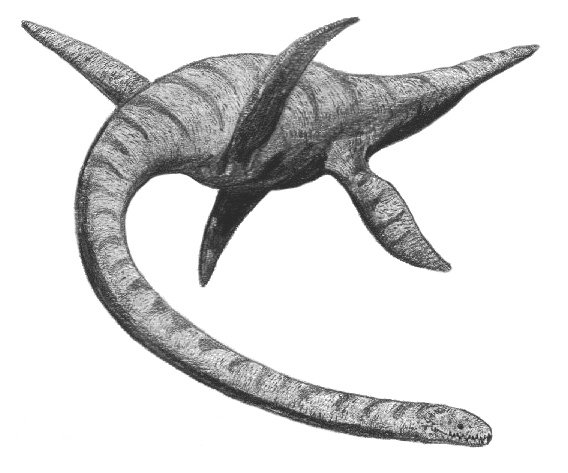Plesiosaurus
From Wikipedia, the free encyclopedia
[Photo] Plesiosaurus drawing by Adam Stuart Smith. Source www.plesiosauria.com Date 2002. Author Adam Stuart Smith, Department of Zoology, University College Dublin
Fossil range: Early Jurassic
Plesiosaurus (Greek: plesios, near to + sauros, lizard) was a large (about 3 to 5 meters long), marine Sauropterygian reptile that lived during the early part of the Jurassic Period, and is known by nearly complete skeletons from the Lias of England and Germany. It was distinguished by its small head, long and slender neck, broad turtle like body, a short tail, and two pairs of large, elongated paddles. It lends its name to the order Plesiosauria, of which it is an early but fairly typical member.
Discovery
Plesiosaurus was one of the first of the "antediluvian reptiles" to be discovered (by Mary Anning), and excited great interest in Victorian England. It was so-named ("near lizard") by William Conybeare, to indicate that it was more like a normal reptile than Ichthyosaurus, which had been found in the same rock strata just a few years previously.
Description
The snout is short, but the mouth was able to open very wide, and the jaws are provided with a series of conical teeth in sockets, much like those of the living gavial. The neck is long and slender, but seems to have been rather stiff, because the vertebrae are nearly flat-ended, which indicates that it could not have been bent in the swan-fashion represented in many old restorations. The other vertebrae are similarly almost flat-ended and firmly united, and there is no sacrum. The ribs are single-headed, and in the middle of the trunk, between the supports of the paired limbs, they meet a dense plastron of abdominal ribs. The short tail is straight and rapidly tapering,
The pectoral and pelvic girdles which support the paired limbs are greatly expanded, the pectoral arch being similar to the corresponding bones of turtles.
The limbs are elongated paddles, with five complete digits, although each consists of a very large number of phalanges. Some traces of skin discovered suggest that it was smooth, not scaly.
Food and Hunting
Plesiosaurus fed on belemnites, fish and other prey.It's U-shaped jaw and sharp teeth would have been like a fish trap. It propelled itself by the paddles, the tail being too short to be of much use. It's neck could have been used has a rudder when making turn during a chase.
Ecology
It is unknown if Plesiosaurs laid eggs on land like sea turtles or give live birth in the water like sea snakes. The young might have lived in estuaries before going in the open ocean.
Species
At one time, Plesiosaurus was a wastebasket taxon used to describe any Mesozoic plesiosaur of generally similar appearance. More recently there has been a number of revisions in sauropterygian taxonomy, and many species previously included here have been moved to other genera and families. Only two species are unambiguiously recognised.
Plesiosaurus dolichodeirus is the type species, known from the Lower Lias (Sinemurian) of Lyme Regis, which was about three metres long. Other plesiosauria from the same formation seem to have measured five to six metres in length.
Plesiosaurus guilelmiimperatoris is known from a large almost complete skeleton from the Upper Lias (Toarcian) of W??rttemberg. There seems to be the impression of a rhomboidal flap of skin in a vertical plane; if so, many plesiosaurs may have been equipped in this way.
In popular culture
The 1975 film The Land That Time Forgot features a Plesiosaurus attacking the crew of a U-boat.
http://en.wikipedia.org/wiki/Plesiosaurus
| The text in this page is based on the copyrighted Wikipedia article shown in above URL. It is used under the GNU Free Documentation License. You may redistribute it, verbatim or modified, providing that you comply with the terms of the GFDL. |
|

